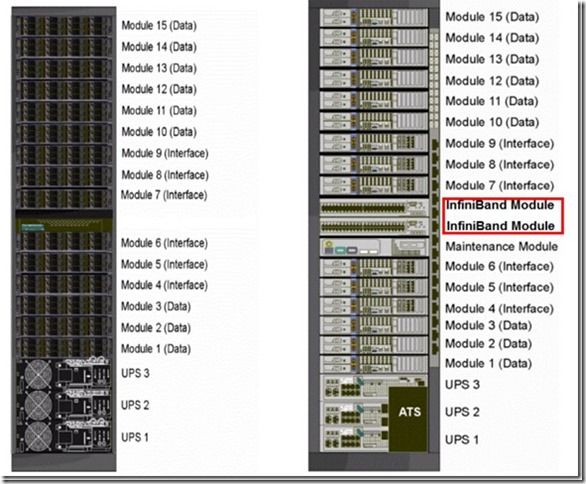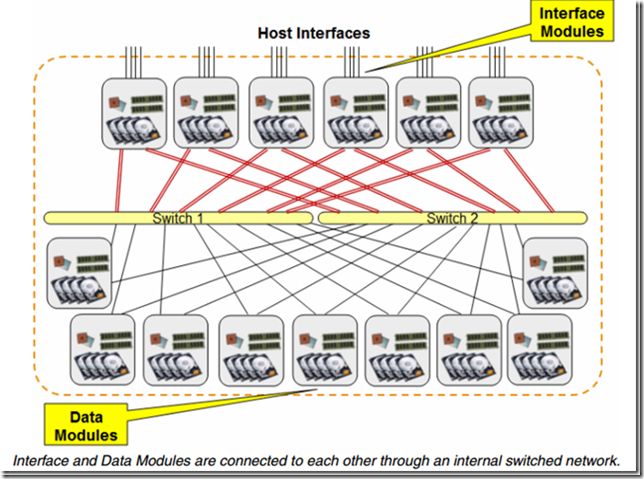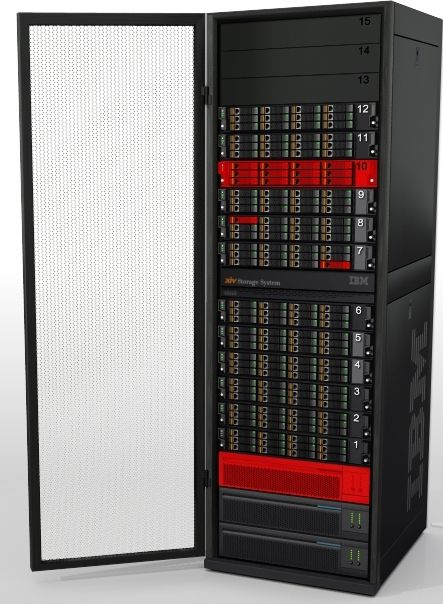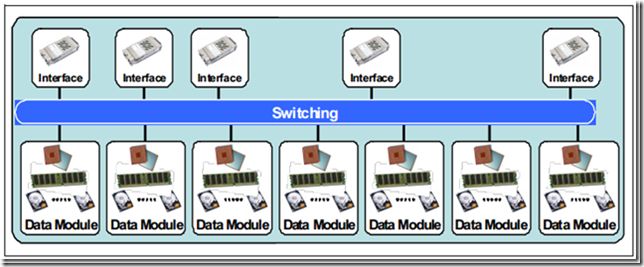IBM XIV被业内称为革命性的新一代存储架构,它是采用了大规模并行的分布式网格存储技术,使用了“Scale out”(横向扩展)的存储架构,利用多路网格模块并行分担存储负荷,并通过细粒度数据分布算法保证数据的恒定均衡分布,它不但提高了系统的可靠性、可用性和存取效率,还易于扩展。
1,System models and components
Machine type 2812-A14
Machine type 2810-A14
Machine type 2812-114
Machine type 2810-114
IBM XIV-A14 Storage System components: Front and rear view [(also known as Generation 2 systems) ]
IBM XIV-114 Storage System components: Front and rear view[also known as Gen3 systems]
2,Hardware elements
2.1,Modules
Module是XIV中最基本的概念,有3种Module:
Data Modules--存数据,处理数据
At a conceptual level, the Data Modules function as the elementary “building blocks” of the system, providing storage capacity, processing power, and caching, in addition to advanced system-managed services. The Data Module’s ability to share and manage system software and services are key elements of the physical architecture
Interface Modules--提供IO接口
Interface Modules are equivalent to Data Modules in all aspects, with the following exceptions:
In addition to disk, cache, and processing resources, Interface Modules are designed to include both Fibre Channel and iSCSI interfaces for host system connectivity, remote mirroring, and data migration activities.
Module interconnect switches--连接各个Module
The XIV Storage System contains a redundant switched network that transmits both data and metadata traffic between the modules. Traffic can flow in any of the following ways:
Between two Interface Modules
Between two Data Modules
Between an Interface Module and a Data Module
Architectural overview
可以看到这个系统里有12个module,其中module10是fail状态
3, Scalability
Design principles
The IBM XIV Storage System grid architecture, by virtue of its distributed topology and “off the shelf” Intel components, ensures that the following design principles are possible:
Performance:
– The relative effect of the loss of a single component is minimized.
– All modules are able to participate equally in handling the total workload.
This design principle is true regardless of access patterns. The system architecture enables excellent load balancing, even if certain applications access certain volumes,or certain parts within a volume, more frequently.
Compatibility:
– Modules consist of standard “off the shelf” components.
Because components are not specifically engineered for the system, the resources and time required for the development of newer hardware technologies are minimized.
This benefit, coupled with the efficient integration of computing resources into the grid architecture, enables the system to realize the rapid adoption of newer hardware technologies available without the need to deploy a whole new subsystem.
Scalability:
– Computing resources can be dynamically changed
– “Scaled out” by adding new modules to accommodate both new capacity and new performance demands
– “Scaled up” by upgrading modules
IBM XIV Storage System scalable conceptual grid architecture
Proportional scalability
Within the IBM XIV Storage System, each module contains all of the pertinent hardware elements that are necessary for a grid topology (processing, caching, and storage). All modules are connected through a scalable network. This aspect of the grid infrastructure enables the relative proportions of cache, processor, disk, and interconnect bandwidth to remain optimal even in the event that modules are added or removed:
Linear cache growth: The total system cache size and cache bandwidth increase linearly with disk capacity, because every module is a self-contained computing resource that houses its own cache. Note that the cache bandwidth scales linearly in terms of both host-to-cache and cache-to-disk throughput, and the close proximity of cache, processor, and disk is maintained.
Proportional interface growth: Interface Modules house Ethernet and Fibre Channel host interfaces and are able to access not only the local resources within the module, but also the entire system. With every Interface Module added, the system proportionally scales both the number of host interfaces and the bandwidth to the internal resources.
Constant switching capacity: The internal switching capacity is designed to scale proportionally as the system grows, preventing bottlenecks regardless of the number of modules. This capability ensures that internal throughput scales proportionally to capacity.
Embedded processing power: Because each module incorporates its own processing power in conjunction with cache and disk components, the ability of the system to perform processor-intensive tasks, such as aggressive prefetch caching, sophisticated cache updates, snapshot management, and data distribution, is always maintained regardless of of the system capacity.
参考书籍《SG24-7659-03,IBM XIV Storage System:Architecture, Implementation,and Usage》.






